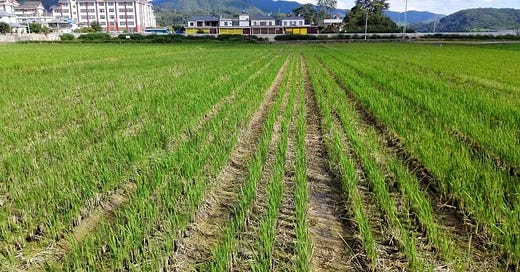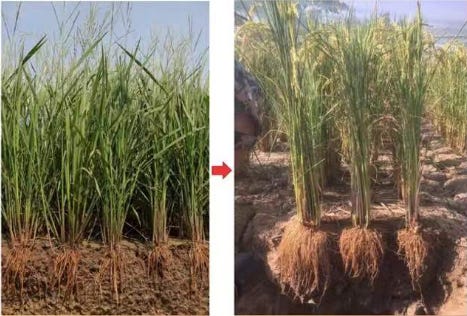I still remember my first impression of Kernza, the first perennial crop that were planted by farmers in Minnesota after perennial crops gradually disappeared in our world for several thousand years.
And I was so delighted to know recently, perennial rice is now planted in Yunnan province, southern China, and in some other areas such as Uganda and Ethiopia in Africa, with the help of Chinese scientists.
It is a long story.
It was in 2015 when I went to the Land Institute in Kansas and met Wes Jackson, the pioneer who devoted more than 40 years on research of perennials. At that time, Kernza, a perennial grain developed from wheatgrass, just began to be planted in small scale in Minnesota. I tasted the flavor of Kernza flour. It was not bad :) And I learned it could be used to make bread and cookies. Several years later, I learned that Kernza beer gets popular in the United States. But I did not have a chance to sip, as I went back to China before Donald Trump was elected as president and never returned to the U.S.
A lot of things happened between China and the U.S. during the past 7 years. But the cooperation between Chinese and U.S. scientists are yielding and benefiting more people in the world.
I was told in the Land Institute that scientists there were working with a Chinese team in Yunnan on perennial rice, which may be the second perennial crop that planted in large scale by farmers someday.
Now the day comes. When I paid a recent visit to the BGI group, a leading life science and genomics research organization, I was told that they are working with the perennial rice team in Yunnan to promote the large scale localization of the crop in China and the world. The perennial rice is now planting in 18 countries, large or small scale.
Africa is a very important continent to the perennial rice. Not only because the crop is planted there, it is also where the important parts of genes came from. The perennial rice was developed after incorporated African Oryza longistaminata wild rice genes, which also enhances stress tolerance.
Compared to annually cultivated rice, perennial rice can reduce production costs by over 50%. And just like Kernza, perennial rice greatly reduce the loss of top soil.
In terms of yield, it reaches 164 kilograms per acre in Yunnan, compared to China’s average of 75 kilograms per acre. Perennial rice obviously produces high yields with less intensive field management.
The Academy of Agricultural Sciences in Uganda has collaborated with BGI to conduct research trials. With less intensive field management, perennial rice still managed to achieve a single-season yield of nearly 82 kilograms per acre.
(LEFT: Yin Ye, BGI CEO; RIGHT: Hu Fengyi, leading scientist of Yunnan perennial rice team )
Rice is the second most important source of calories in Africa. Further adoption of perennial rice is potentially of great importance to the food supply of African countries.
Apart from its work on existing staple food crops, BGI is an active member of the African Orphan Crops Consortium (AOCC). These local orphan crops which have been neglected by the global scientific community, have special adaptability to grow in these environments. BGI sequences these orphan crops to identify genes that have potential to impart tolerance to high temperatures, drought, and high salinity while providing excellent nutrition. So far, BGI has sequenced over 10 orphan crops, such as African eggplant, breadfruit, jackfruit and the moringa.
I can not forget what Wes Jackson told me. “We have no other choice. We have witnessed the fall of civilizations due to deterioration of soil after years and years of ploughing. If we continue farming annual crops, our civilization will be at risk,” he said while looking far ahead across the prairie around the Land Institute.







Thank you, so interesting! I've recently been reading the first volume (The Structures of Everyday Life) of Fernand Braudel's 'Civilization and Capitalism, 15th - 18th Century'. It contains some really interesting comparisons between the relationships between rural and urban areas in China and the West as reflected in how their staple crops (rice vs. wheat) were grown.
I added this article to the China Tech Database,
https://chinarising.puntopress.com/2018/03/20/china-tech-invention-innovation-technology-research-and-development-past-present-future-5000-years-of-progress-a-china-rising-radio-sinoland-living-document/
Thanks! Jeff